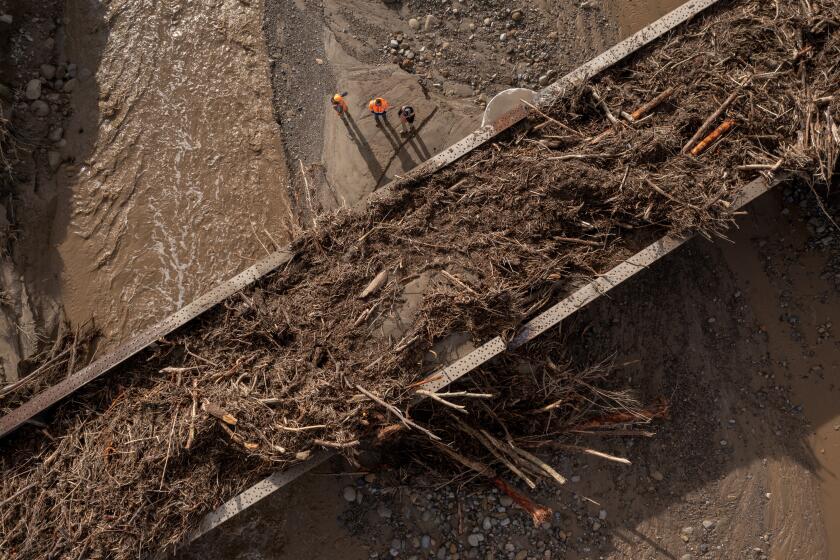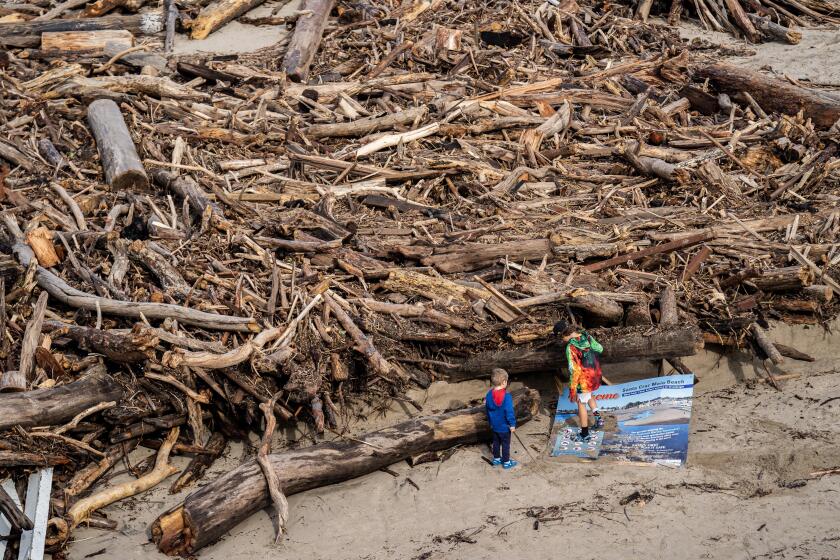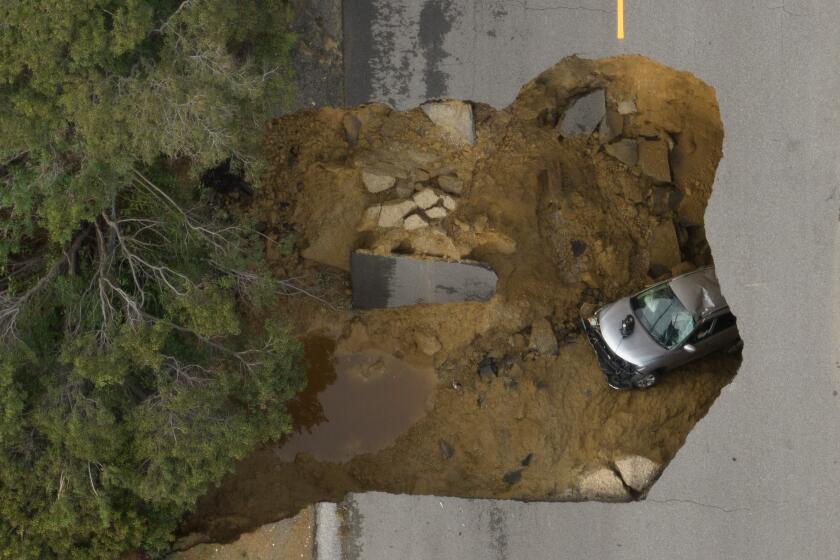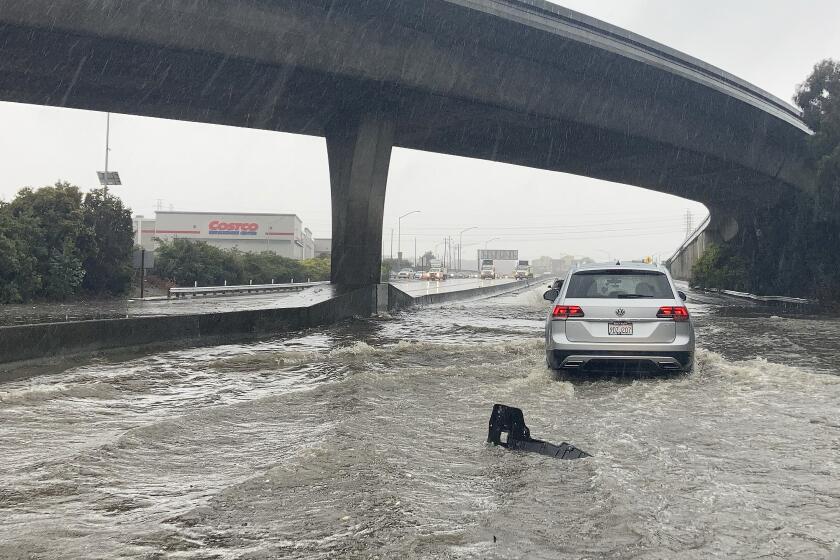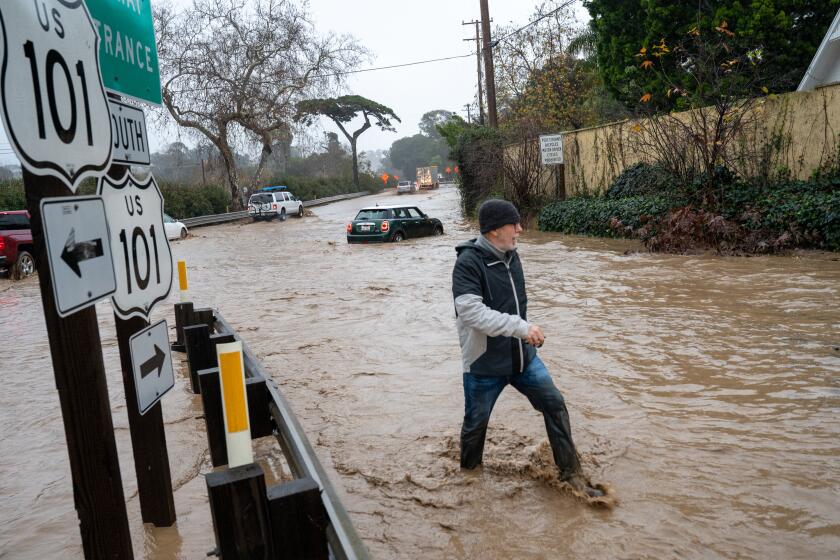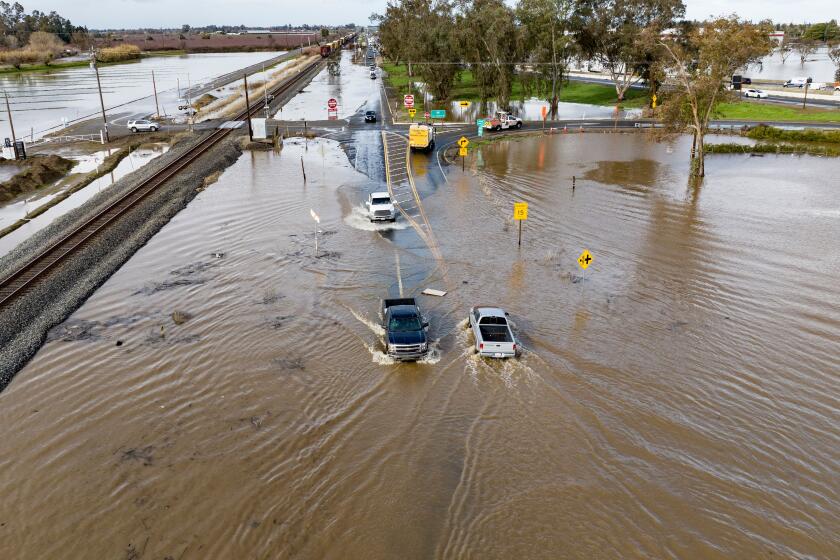California storm death toll reaches 17 as floods and extreme wind wreak havoc
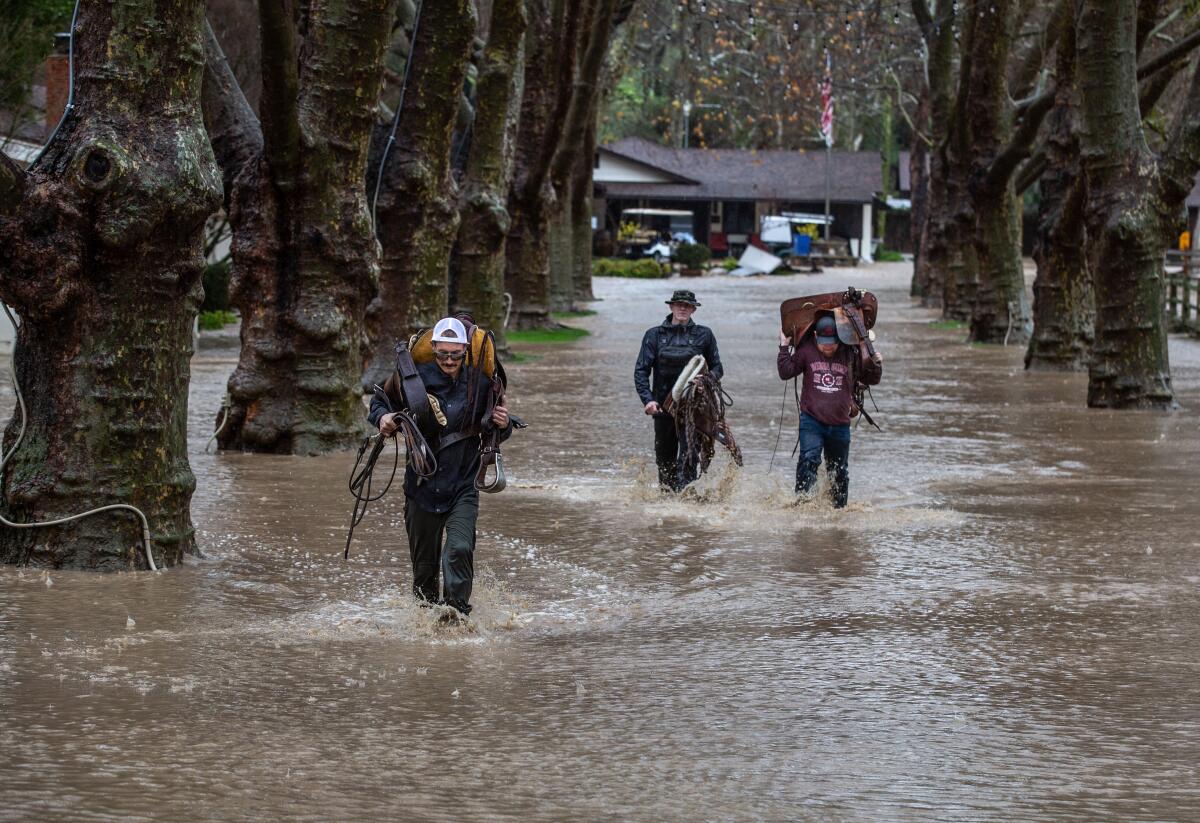
CAPITOLA, Calif. — The latest in a series of intense winter storms continued to lash Northern California on Tuesday, bringing thunderstorms, heavy rain, wind and hail to the waterlogged region as the death toll from the extreme weather climbs.
The back-to-back atmospheric rivers that have battered the Golden State have led to at least 17 deaths, including those of two motorists who died early Tuesday in a crash on Highway 99 in Tulare County when a tree that had been struck by lightning fell onto the road, authorities said.
“These conditions are serious and they’re deadly,” Gov. Gavin Newsom said during a news conference in Capitola on Tuesday, adding that the number of deaths “tragically is likely to grow.”
As of Tuesday afternoon, 31 of California’s 58 counties had been declared disasters, he added. More than 30,000 people across the state have been evacuated from their homes.
The powerful storm that knocked out power, toppled trees — including one that killed a toddler — and flooded homes along the coast in Santa Cruz continued its march through the region.
President Biden called Newsom from Mexico City and left a voicemail to offer support after the devastating floods, a White House official said Tuesday. Two days earlier, Biden approved an emergency declaration for California that authorizes the Federal Emergency Management Agency to coordinate disaster relief efforts and provide resources.
About 155,000 Pacific Gas & Electric Co. customers were without power after efforts to restore service overnight were stymied by wind gusts exceeding 70 mph in some areas and more than 100 lightning strikes, according to the utility.
Though it’s too early to estimate, the cost to repair the damage from these storms could exceed $1 billion, said Adam Smith, an applied climatologist and disaster expert with the National Oceanic and Atmospheric Administration. The U.S. had 18 weather and climate disasters last year whose costs reached $1 billion, tying 2017 and 2011 for the third-highest number of such incidents, according to a NOAA report. California’s storms would be the first billion-dollar disaster of 2023.
Strolling along the Esplanade in downtown Capitola on Tuesday afternoon, Newsom ducked into three restaurants that had been pummeled last week by the storm surge, with its 20-foot waves that carried trees and broken lumber from the city’s wrecked wharf.
Lamenting the unrelenting rain, the governor said, “We are soaked. This place is soaked.” Any new precipitation, even if mild, could have “huge implications on the ground,” he said.
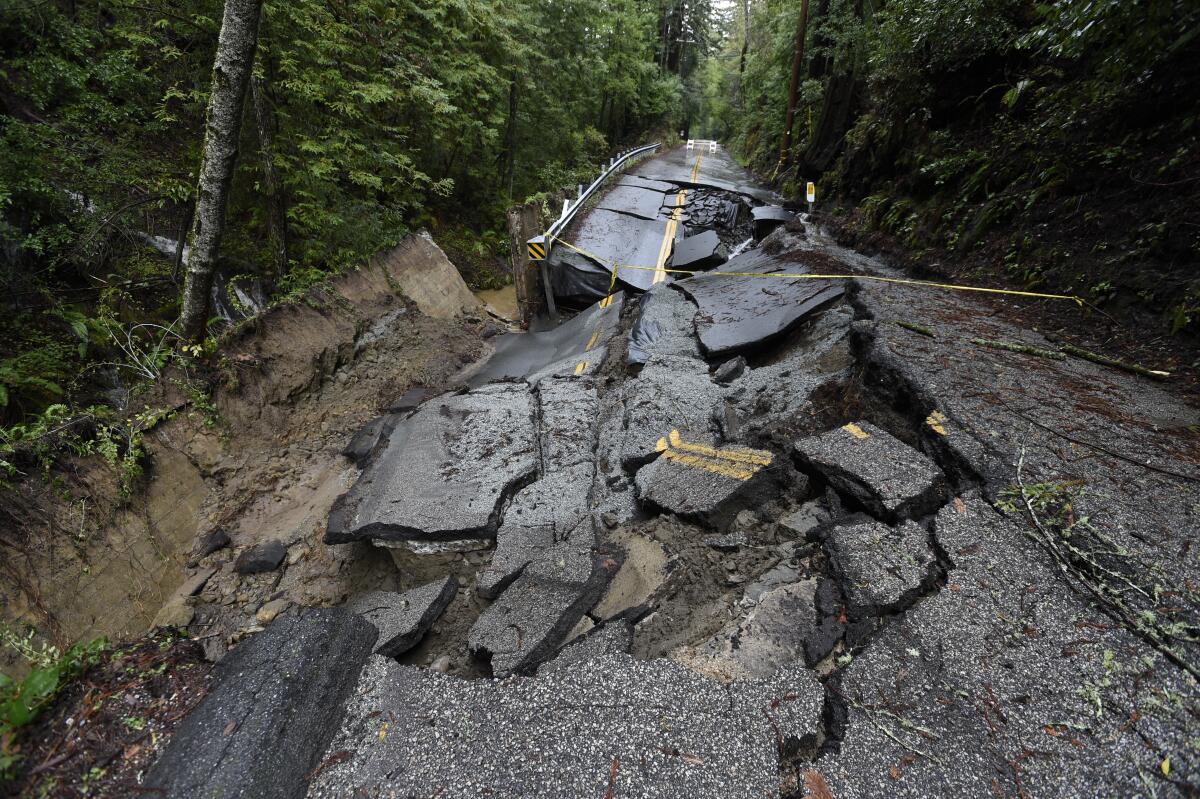
Newsom then spoke about the “weather whiplash” Californians have faced in the last several years between extreme drought, heat waves, wildfires and rain and flooding.
“The hots are getting hotter … the dries are getting a lot drier,” he said. “And the wets are getting a lot wetter.”
Patrick Lynn, owner of the Bay Bar and Grill near Capitola Beach, figured Thursday’s storm would be run-of-the-mill and put some sandbags out front. Then he got a call from a nearby business owner that his bar was being destroyed.
The waves were so strong that they lifted up the floor of the bar and cracked it down the middle, said Lynn, 53. His back windows were also blown out.
Destructive storms will “rearrange the whole coastline” in battered Santa Cruz County
“I had seawater splash on top of my television that’s about 8 feet high,” he said. “It was almost hitting my ceiling and coming through the drapes and front of the bar; it just blew everything apart. It was unbelievable.”
This week’s storms have continued to break apart portions of the bar.
“That bar was my life,” said Lynn, who has yet to find out whether he will receive state and federal assistance or an insurance payout. “It helped save me because I didn’t know what I was going to do with the rest of my life.”
The Felton area of Santa Cruz County, portions of which were flooded Monday by the rising San Lorenzo River, also sustained major damage overnight from powerful winds gusting up to 70 mph that toppled trees. Highway 17 was closed after power lines went down and were sparking on the roadway, according to the National Weather Service.
Some major roads remain closed because of flooding, rock slides and debris flows, while crews have responded to a significant mudslide in Studio City and a major sinkhole in Chatsworth.
San Francisco, which was under a flash flood warning Tuesday, has logged its third-wettest 15-day period on record, according to Jan Null, an adjunct professor of meteorology at San Jose State.
Storms have dumped 12.37 inches of rain on San Francisco since Dec. 26. The only two wetter 15-day periods have been in December 1866, when 13.54 inches fell, and during the Great Flood of 1862, which saw more than 19 inches of rain.
Pea-sized hail was reported in San Francisco and Oakland, and in Walnut Creek a mile-long stretch of Ygnacio Valley Road, a major thoroughfare, was closed after a tree fell on a power line.
On Tuesday, a tree toppled onto a Muni bus in San Francisco, officials said. No one was injured.
Lightning struck Sutro Tower, a 977-foot structure that delivers TV and radio signals and is a recognizable part of the city’s skyline. San Francisco’s Department of Emergency Management said there was no reported effect on the communications equipment.
In South San Francisco, aggressive winds pulled back a section of the decking on an apartment building’s roof around 2 a.m. Tuesday, sending rainwater into two units. The entire four-unit building was evacuated and no one was injured, said Matt Samson, the city’s deputy fire chief.
“The amount of rain that’s just been continuous has been something we haven’t experienced in quite some time,” Samson said. “We’re not getting much reprieve. The ground isn’t getting much time to dry out and then we’re getting accompanying winds so we’re seeing quite a few trees come down.”
When an evacuation order reaches you, you need to leave. Now. Here’s how to prepare and what to have ready to go if you may need to evacuate during the rainstorms hitting California.
In the Sacramento area, forecasters observed rotation on radar indicating favorable conditions for tornado formation and issued a tornado warning, though no twisters materialized, said Cory Mueller, a meteorologist with the National Weather Service.
As far south as Modesto, residents reported being jolted awake shortly before 4 a.m. by an emergency alert warning them to get to a basement or low level of the house because of a tornado threat.
The strong winds wreaked havoc in the area, knocking over a tractor-trailer and leaving it dangling on an overpass, and toppling trees across El Dorado, Amador and Sacramento counties.
A tornado warning issued by the National Weather Service in Tulare County lasted about 30 minutes Tuesday evening. Forecasters still warned residents of winds up to 40 mph and possible pea-sized hail.
In Merced County, sheriff’s deputies evacuated 4,000 residents in the town of Planada, just east of Merced, after Bear Creek began to flood amid heavy rain.
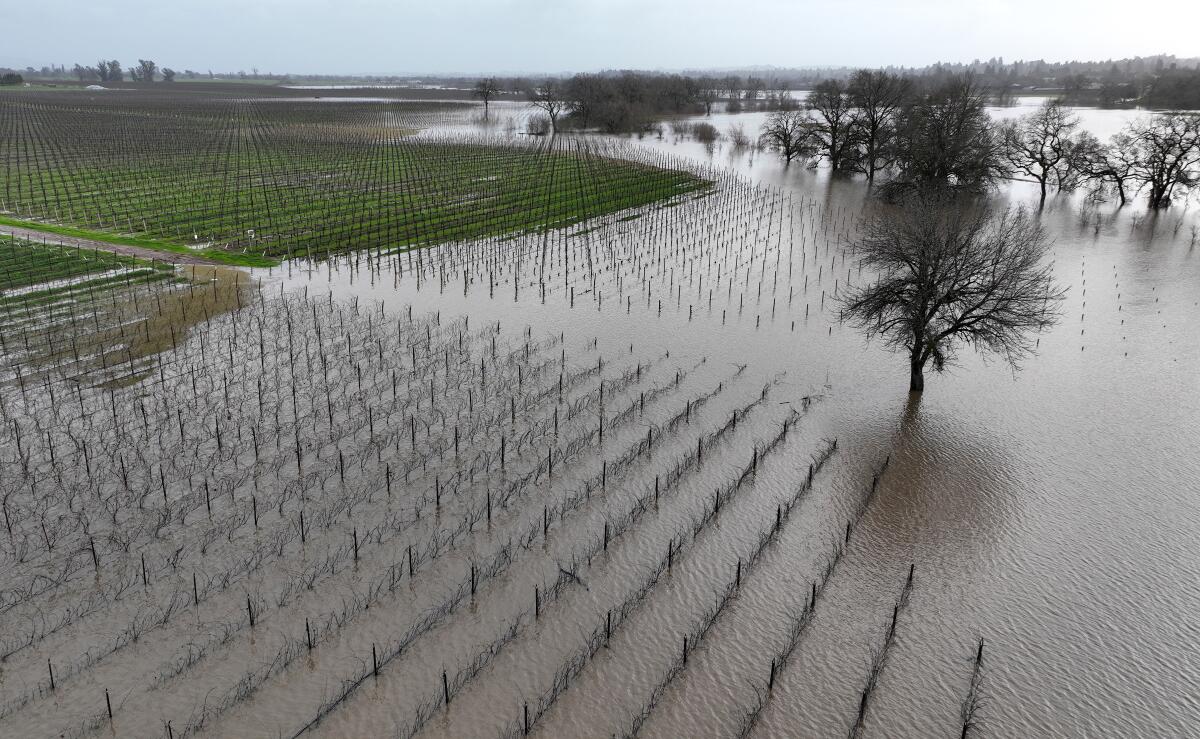
Bear Creek, which bisects Merced, reached major flood stage early Tuesday, pushing muddy water into neighborhoods that sent cars drifting near half-submerged stop signs.
County Supervisor Rodrigo Espinosa, who represents the area, said he spent Monday evening laying sandbags in Planada in a fruitless attempt to hold back the water. After several hours, it became clear the whole community would have to be evacuated.
“We didn’t think it was going to be that bad,” he said of the flood risk. “And there are two more storms coming.”
Alex Martinez, 29, who grew up in Planada but now lives in Merced, rushed over in his lifted truck to help family members evacuate.
Here are the many highways and freeways that are shut down across California as a result of the powerful storm —and tips for driving safely in the muck.
As he waited for them to load their cars, he launched a drone camera, which showed revealed a town covered in feet of water.
Many residents will face a long road ahead, even after the water recedes. The unincorporated community is made up of about 90% renters, very few of whom are likely to have flood insurance, officials said.
“It’s really devastating,” Martinez’s fiancee, Monica Manzo, 30, said.
“You almost feel hopeless,” Martinez added.
Dennis Spurlock, 53, drove with his brother to their childhood home in Planada on Monday night and convinced their mother to evacuate. The water reached about 3 feet high in the house, caved in the garage and destroyed the fence in the front, he said.
The rural town is among numerous communities hit hard by days of relentless rain and flooding from the California storms.
Spurlock owns a dairy equipment business in the town and said there was about 8 inches of water in his building Tuesday.
“My family has lived in that town since the 1930s,” he said. “I’ve never seen a flood like that.”
Katie Bass, 35, a Fresno resident who owns San Joaquin Drug in Planada, arrived at her store Tuesday morning to find the building wasn’t damaged but the power was out. She rushed to save vaccines and insulin, which need to be refrigerated.
In Monterey County, sheriff’s officials issued an evacuation order for residents near the Salinas River and along a stretch of the Carmel Valley early Tuesday. County officials on Tuesday night downgraded an evacuation order for areas along the Big Sur River to an evacuation warning.
Officials anticipate the Salinas River could reach flood stage by Wednesday, according to the California Nevada River Forecast Center.
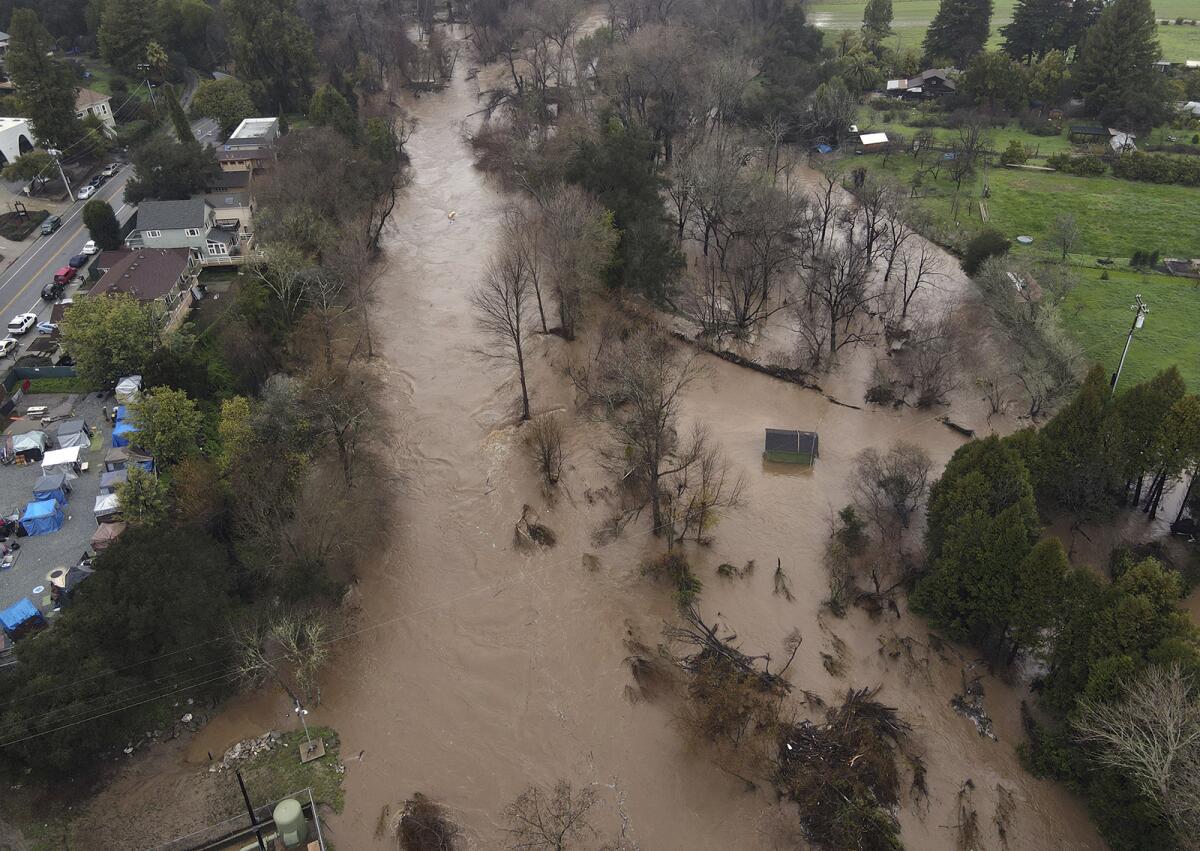
Some closely watched waterways were receding Tuesday, including the Pajaro River in Monterey and Santa Cruz counties and Bear Creek in Merced, said Jeremy Arrich, manager of the Division of Flood Management with the Department of Water Resources.
But at least seven sites, including the Russian River in Sonoma and Mendocino counties, were forecast to exceed the flood stage in the coming days, he said at a news conference.
Since activating the state-federal Flood Operations Center last week, officials have delivered materials to 17 counties, including 389,000 sandbags, 3,000 feet of reinforcing muscle-wall and more than 500,000 square feet of plastic sheeting for levee protection, Arrich said.
As the tail end of the atmospheric river moves through the region, officials said Tuesday’s storm was the sixth in a series that could climb up to nine.
It was too soon to say whether the worst was over, state climatologist Mike Anderson said. High pressure systems were starting to interact with the atmospheric rivers, he said, which could mean less-destructive storms going forward — but the cumulative effects remained a major concern.
“It’s not that any individual storm is a big, scary one; it’s what are the cumulative impacts, because it’s really rare for us to get into storms seven, eight and nine,” he said. “We just don’t have that many in the historical record.”
Rust reported from Capitola, Rong-Gong Lin II from San Francisco, Fry from Orange County, Summer Lin and Sheets from Los Angeles and Garrison from Sacramento.
More to Read
Sign up for Essential California
The most important California stories and recommendations in your inbox every morning.
You may occasionally receive promotional content from the Los Angeles Times.
